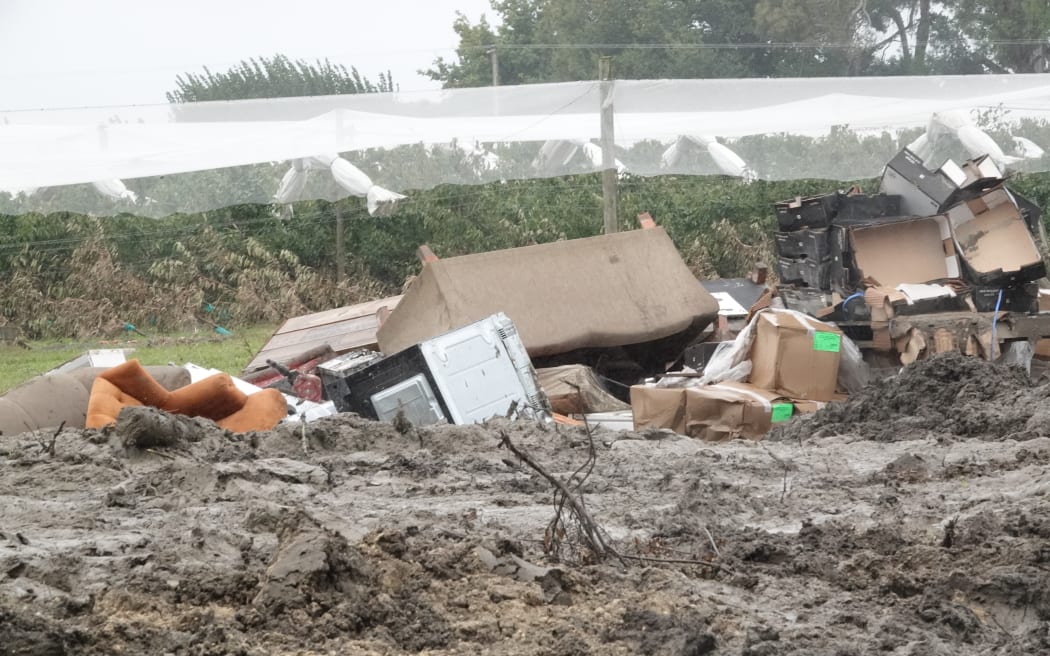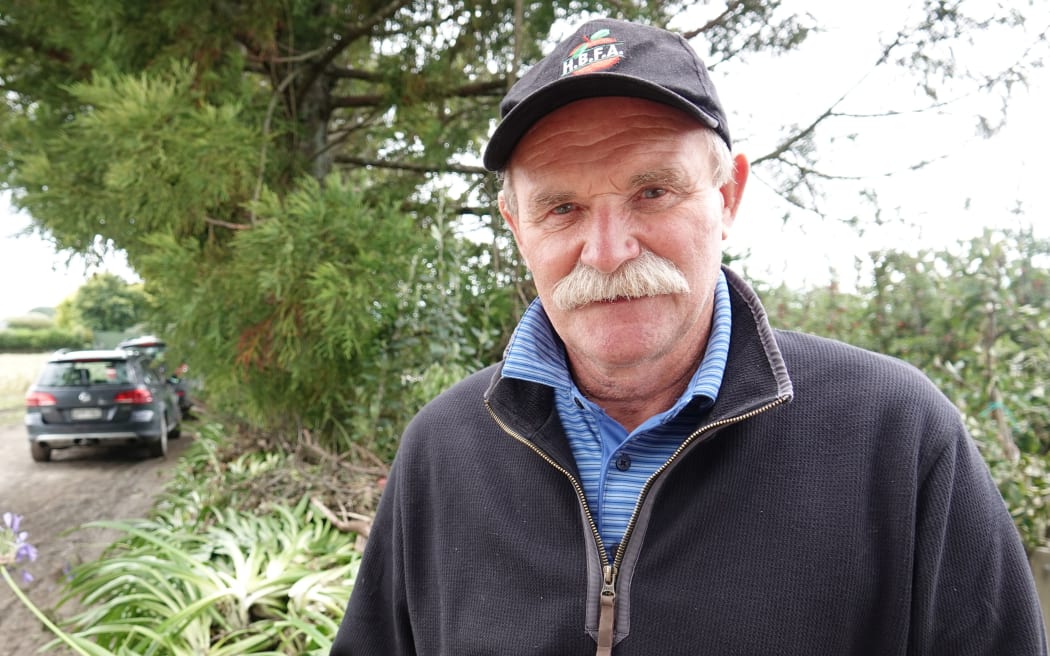Six months after the Cyclone Gabrielle devastated parts of Hawke's Bay, growers in one of New Zealand's fruit bowls are slowly getting back on their feet.
Apples and pears alone make up an industry worth about $550 million to the region, so the tropical cyclone of 14 February delivered a sucker punch that will take years to get over.
At Twyford, near Hastings, Riverside Cherries owner Jerf van Beek is more positive than when RNZ met him just days after Gabrielle.
Back then staff were working to get oxygen to the roots of his 7 hectares of cherry trees.
He was unsure how they would fare, but in the end the losses were not too bad.
"We're being able to resurrect the cages again. We're in the process of rebuilding all the netting, the structures - posts were snapped, cables were snapped. I'm almost halfway through that.
"That's a real blessing because that's a key business and something that's more or less my hobby that I really enjoy doing.
"We lost half a hectare [of cherries] behind the house, where the flood was just too strong and the cage was irreparable.
"We're replacing that, but we're planting another hectare of cherries, new cherries."
That will mean he now has 7 1/2 hectares.
However, little remains of the apple orchard van Beek was leasing out on the rest of his property.

Much of van Beek's orchard was destroyed. Photo: RNZ / Jimmy Ellingham
Much of it was wiped away by floodwater, which pulled out trees, posts - everything in its path.
"The bulk of the water that actually came through the break in the Ngaruroro [River] just opposite Fernhill came through this particular area.
"Water generally goes where it wants to go and it just completely ripped out 6 hectares of our valuable young planting who were in almost full production.
"Fruit was hanging on and if you look at it now it's just green grass left behind. The trees were completely ripped out."
The final piles of rubbish are ready for burning, before ploughs hit the ground and the land is planted with crops such as squash, maize and maybe onions.
Van Beek said his family's efforts had concentrated on time-critical work getting the land and cherries sorted. Attention would then turn to the house he built two decades ago, which was inundated with water.
For now, the straw bale-lined structure, constructed using wood from the property, was secured and dried out.
"We've put 6x2 framing inside, with reinforcement steel. Then we sprayed concrete in. That's about 100 millimetres think. Then we put another framing on the inside to make sure [the walls] are now secure.
"We can leave this standing for 12-18 months if we had to. Even an earthquake wouldn't damage this, because we wanted to keep the integrity of the house and the look of the house."
Meanwhile, the family are staying in a garage upgraded to a warm, comfortable living quarters.
"It will happen, but first we're going to do a harvest of cherries. We're going to do a season of cherries because that's time critical. The house is not."
He had no problems with insurance and was feeling optimistic.
Van Beek had even helped other growers clean up as a way of repaying the kindness shown to him when volunteers arrived to shovel silt and help at his property in Gabrielle's aftermath.

Leon Stallard's orchard was heavily damaged in February. Photo: RNZ / Jimmy Ellingham
For apple grower Leon Stallard, who has 8 hectares between Pakipaki and Havelock North, life is a waiting game as only time will reveal if his trees have survived the ponding on the property.
"We won't know until the buds break, really. It's a real unknown at this stage. We're always optimistic that it could be OK.
"In the autumn time when they lost their leaves they were still underwater, but they appeared to operate normally. The leaves seemed to hang in there until the end, which is what you want to see.
"There was no sense of them defoliating too early."
During the cyclone Stallard's land filled with water, which had nowhere to drain. It remained for most of the winter.
"We finally got rid of the water last week, to be honest. It's gone once or twice, but every time it rains now [it comes back].
"We've nearly had 800mm of rain for the year. For the whole year normally we get under 700mm so we're into next year's rain already and we're only early August.
"We have been pumping the water out of the orchard, but part of the problem is the water table is on top of the surface. The ground is absolutely saturated."
When RNZ visited Stallard's orchard in February, we sloshed around in mud, looking at apples waiting to be picked.
Some fruit was harvested, but much had to stay on the trees - lost income simply left to wither.
"[On one block] we started harvesting in about two inches of water and after about half an hour we were in six inches of mud. The ladders that the guys were working on were just disappearing into the ground. We couldn't get them to climb a ladder because it was just too dangerous.
"We ended up having to harvest what we could, but then walk away from a lot of fruit just because we couldn't access the ground."
Stallard said he would have to consider his future if his trees did not survive - an unenviable position many growers faced.
"People are optimistic but pessimistic, if that makes sense. There are a number of people who have basically lost everything....
"There's some really major critical decisions that have to be made for a number of growers in the next few years."
Getting up and running again would not be easy with the cost of trees and royalties.
"You're talking $200,000-plus, a hectare. If you've got three or four hectares you've got to borrow $1 million with no income, so how am I going to pay that back and who's going to lend me that?"

